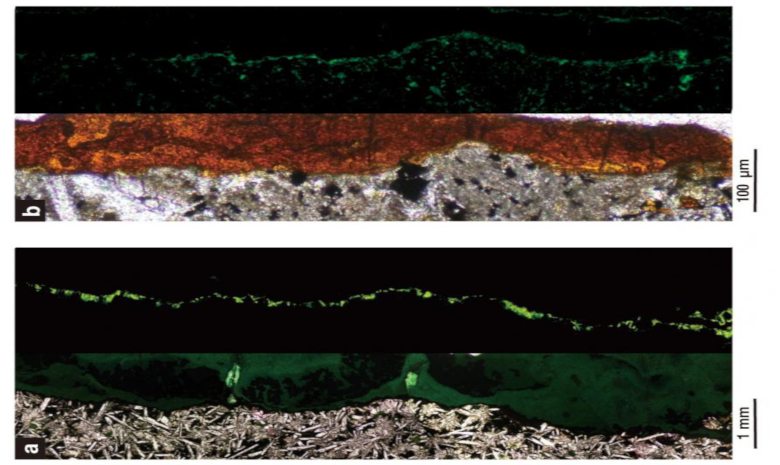Scientists have found microbial life tucked away in 33–104-million-year-old volcanic rock more than 100 metres below the sea floor, a finding that has implications for the possibility of life on Mars and other planetary bodies, where rocks of this type make up a large proportion of the crust.
The upper oceanic crust, which covers about 60 percent of the surface of the Earth, is one of the largest habitable zones on Earth. It has been continuously created on Earth for ~3.8 billion years and is formed from molten rock which rises to the seafloor from the mantle, producing enormous volcanic eruptions of basalt at positions called mid-ocean ridges.
These areas are literally hotspots for hosting chemosynthetic life – organisms that utilise chemicals rather than sunlight (photosynthesis) for food. After obtaining energy from high-temperature basalt-seawater reactions, the microbes find their way into solidified lava that has cooled down and cracked as it becomes rock.
These cracks are often less than 1 millimeter (0.04 inch) across and over millions of years, those cracks fill up with iron-rich smectite; a type of clay mineral that contains iron and magnesium as well as either sodium or calcium and is the same clay used to make pottery.
As might be expected, finding signs of ancient, tiny microbes in rocks hidden deep underwater, is not particularly easy. The clay-loving microbes discovered in this study were found in rocks collected by a team from the University of Tokyo during the Integrated Ocean Drilling Program (IODP). The expedition, which anchored above three locations along the route across the South Pacific Gyre (a region from the tropical island of Tahiti in the middle of the Pacific Ocean to Auckland, New Zealand), used a metal tube 5.7 kilometres long to reach the ocean floor, then pulled out core samples from 125 metres below the seafloor.
The expedition was in 2010 and it has taken the researchers nearly ten years of trial and error to determine that what they were actually looking at was indeed a microbe and not a mineral or some other questionable compound.
"I thought it was a dream, seeing such rich microbial life in rocks," said Associate Professor Yohey Suzuki from the University of Tokyo, recalling the first time he saw bacteria inside the undersea rock samples.
"These cracks are a very friendly place for life. Clay minerals are like a magic material on Earth; if you can find clay minerals, you can almost always find microbes living in them," explained Suzuki.
Previous research has shown that bacteria and other microorganisms that survive on inorganic energy sources exist within 3.5 and 8-million-year old ridge systems. However, little is known about microbial life in oceanic crust that is more than 10 million years old.
The microbes identified by Suzuki and colleagues are thought to be from 33–104-million-year-old basaltic lava samples. And it wasn’t just a few odd microbes they found. The samples were packed say the research team.
Suzuki and colleagues estimate that the rocks contain a community of bacteria as dense as that of the human gut, so about 10 billion bacterial cells per cubic centimeter (0.06 cubic inch). Conversely, the average density of bacteria living in mud sediment on the seafloor is estimated to be 100 cells per cubic centimeter.
The team found the microbial cells using nanoscale secondary ion mass spectrometry (NanoSIMS), which picked up greenish cell-like fluorescence signals (glowing green spheres) along the rims of the rock fractures/veins associated with the iron-rich clay.
A further analysis revealed that the signals were indeed microbial in nature and were not naturally occurring autofluorescent materials interfering with the results. "Honestly, it was a very unexpected discovery. I was very lucky, because I almost gave up," Suzuki said.
As basaltic crusts are not unique to Earth, this finding not only advances our study of life on Earth, but will provide researchers with clues about how they might find life elsewhere in the Solar System.
"This discovery of life where no one expected it in solid rock below the seafloor may be changing the game for the search for life in space," said Suzuki.
Mars for example, is thought to have formed its basaltic crust about 4 billion years ago. Although its surface is now cold and dry, 3 billion years ago, hydrothermal processes and weathering at the Martian surface and in the subsurface formed a glut of iron-magnesium rich clay; a process which lasted for a billion years.
"Minerals are like a fingerprint for what conditions were present when the clay formed. Neutral to slightly alkaline levels, low temperature, moderate salinity, iron-rich environment, basalt rock – all of these conditions are shared between the deep ocean and the surface of Mars," said Suzuki.
"I am now almost over-expecting that I can find life on Mars. If not, it must be that life relies on some other process that Mars does not have, like plate tectonics," he added.











